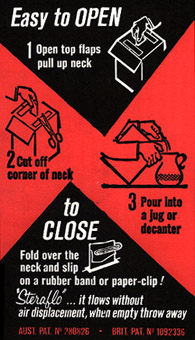
Wine cask
1966
portable, airtight wine container
Australian wine exports are worth millions today, yet the trailblazer for wine exports was the humble bag-in-a-box wine package.
In the mid 1960s a South Australian family winery, Angove's, was looking for a way to sell its cheaper red wines in bulk. The problem with large bottles was that, once they were opened, air got in and the wine would go off in a couple of days. The answer was a modern version of the traditional European wine 'bladder' (a leather pouch that collapses as the wine is poured, keeping air out).
Polyethylene bags were filled with 4.4 litres (1 gallon) of wine and then put into boxes. You simply opened the box, snipped off a corner of the bag and poured the wine.
To close it you squeezed the air out of the bag, sealed it with a special peg and popped it back into its box and into the fridge.
The bag-in-a-box concept took off. In 1967 Penfold Wines and C H Malpas patented a plastic, airless flow-tap welded into a metallised plastic bag. This innovation allowed the bag to stay in the box and be tapped like a traditional wine cask, and that's the version most popular today.
Who Did It?
Key Organisations
Angoves Wines : development & use
Key People
W J Marshall : developer
Further Reading
Australian genius: 50 great ideas
Vivien Encel
Atrand, Crows Nest, NSW, 1988, pp 42-43.
Links
History
of Australian Wines
Invention
- wine cask
Angoves Wines
|











